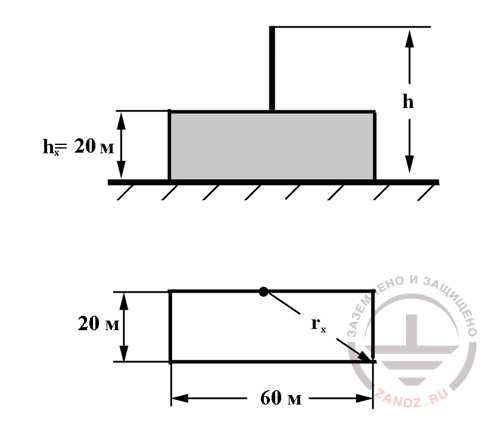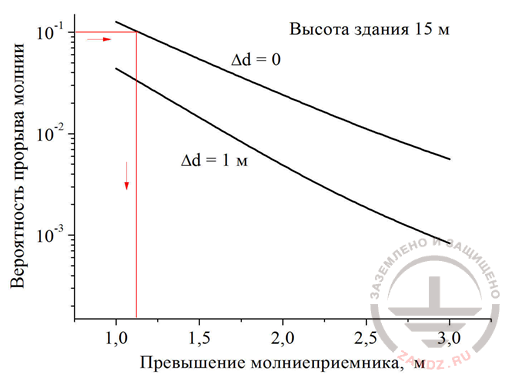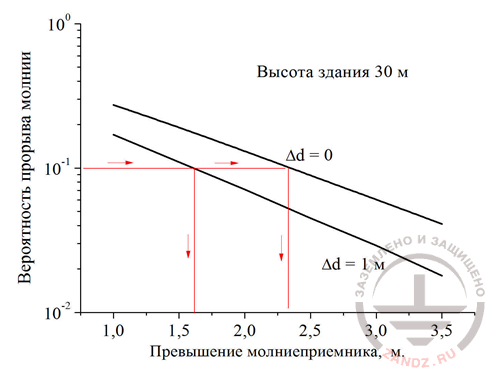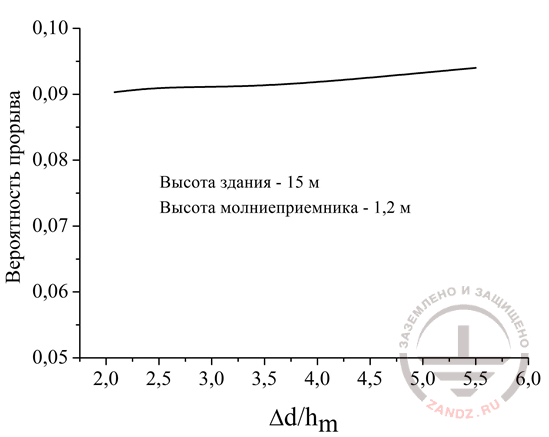Judging by practice, we can conclude that designers prefer to use one high device. The rod lightning rod is especially popular, since the calculations are performed when elementary formulas are used. A simple cone that defines the protected zone is formed. The structure enters the cone - protection is provided for it. At first glance, everything is elementary, but it's not so...
Why is the high rod lightning rod not perfect
To tell about the pitfalls of this technique, I will give an example. Let's take a house of rectangular shape with a height of hx=20 meters, the building size is 60x20 m. The planned placement of one lightning rod is reflected in Figure 1. It is assumed that this protection will have a reliability of 0.9.

Figure 1. Placement of one lightning rod
In the normative IS-153-34.21.122-2003 look at chart 3.4. In accordance with the empirical formulas, we calculate the height of the cone of the protective zone at the height of the rod lightning rod, equal to h.

The size of the radius of the protective circle on the ground at 30

The lightning protection radius at a certain height hx will be equal to

At the same time

For the chosen position of the lightning rod, the radius of the zone at the height of hx=20 m will be

, which implies the height of the protective device h≈54 m. The number of lightning strikes in this lightning receiver depends on the area of contraction, calculated by SM=9πh2≈0,082km2.
This figure makes the lightning contraction sqaure about four times larger, in comparison with the structure itself, without a protective device. The number of close lightning discharges will increase in that many times. Those who deal with the internal lightning protection of residential and public buildings, won't be happy with such indexes. Since the lightning rod, dealing only with the shunk of lightning, does not at all affect the electromagnetic field of its current and does not reduce the voltage that falls on the internal electrical network.
Consequently, it can be concluded that when designing a lightning rod, one should try not to exceed the number of lightning strikes in them, relative to the number of strikes in the structure without lightning protection. This is easier to achieve when installing several small devices than one large.
Calculation of the height of systems of small or mixed lightning rods
It cannot be said that these conclusions are a discovery. Such preferences in the installation of a low, but numerous system of protection of high-rise buildings have long been rooted in Europe. The Russian regulations also give "green light" to such systems. Why is it not widely used in domestic urban development? There are two main reasons:
- The strength of the habit and the simplicity of the calculations make the designers use only single types of lightning rods.
- It is rather difficult to choose the optimum height for several low lightning rods.
Calculation of the protection zone is easy to do if there are one or two rods. When their number is much greater or if several types of lightning rods are used simultaneously, the task becomes practically impossible. Appeal to the standard IS-153-34-21.122-2003 does not solve the problem.
If you turn to section 3.3.1, you can find there only a recommendation to use computer programs that should make an accurate calculation of lightning protection zones when using a rod and cable lightning rod or a combination of several such devices.
Technical memo number 25/2009 of the Association "RosElektromontazh" informs that these criteria are met by the software from JSC "Enin", which was developed on the basis of statistical data. It is true that such software is available, but it cannot be found on the market. It is used only by the employees of the manufacturer. A similar program was also issued by the company "IMAG". Its products are likely to be available in the near future.
Today, while there is no immediate availability of such convenient and accurate software, it is possible to use the provision of that normative document, namely, its paragraph 3.3.2.5, which deals with zones of closed cable lightning protection. These are the same multiple lightning rods. Four metal cables run along the walls of the building, forming a protected area in the center. The best solution is to install cantilever fasteners on the roof. This results in a negative protection angle. If the cantilever fasteners are missing, and the cables descend directly from the roof, the angle of protection is equated to zero.
Closed ground wire system
The system of catenary wire lightning protection requires a more careful study. Let us recall the radius of the zone of lightning contraction. Aspiring to the object, they are located at the distance less than or equal to its height, increased threefold. In high-rise buildings, the size of the contraction will be much smaller than the area of the building itself. For example, let's take a house of 5 floors, an area of 50x12 m. Here the difference in squares will be equal to twenty times excess. This means that the bulk of the blows will fall on the facades of the building. In this case, the cable lightning rod will be very handy, as it will necessarily be in the way of lightning. The protection system, which assumes the use of small lightning rods, will be very effective.
However, there is a danger that the ground wires placed along the perimeter may not show themselves at a large width of the house and vertical lightning strike into the center of the roof. But the probability of such a strike is extremely small, so we can say with confidence that the level of protection of 0.9 will be provided to such a system of lightning rods. Calculation of the height of the ground wire system. In Figures 2 and 3, it is possible to see and evaluate the productivity of a closed system of catenary wire lightning rods for houses of 15 and 30 meters in height, having dimensions of 60 x 20 m. These lightning rods were either at the edges of the roof, or were displaced to one meter (distance Δd). It turns out that the elevation of such a system over the roof level should be quite small.
Thus, houses of the III level of lightning protection of residential and public buildings with a required reliability of 0.9, 15 meters high should be equipped with lightning rods 1.2 meters high (see Fig.2), and 30 meters high - about 2.5 meters (see Fig.3).

Figure 2. Probability of a lightning breakthrough, building 15 m high, lightning rods 1,2 meters

Figure 3. Probability of a lightning breakthrough, building 30 m high, lightning rods about 2.5 meters
The system of rod lightning rods of small size
Such type of lightning protection as a catenary wire can easily be replaced by a rod type with the same height parameters. The question is, at what distance from each other they should be installed. We address to the same document, paragraph 3.3.2.3. Here the zones of the system of rod devices are considered. Calculation of the distance between us is simple: it should not exceed their length more than 2.5 times.
There was a hypothesis that in the absence of a gap between the zones in such a protection system, in terms of its protective properties, it would be equivalent to the section of an evenly stretched cable without sagging. To verify this claim, the software from Enin was used. I must say that all the zones appearing in this documentation were calculated with the help of this computer program.
For the experiment we took buildings 60x20 m, at the height of 15 m and 30 m with an installed system of rod lightning rods 1.2 m and 2.5 m high, respectively. According to figure 4, it is possible to judge how much the probability of lightning strikes breaking through the protection zone depends on the distance from the lightning rods from each other. This distance should be calculated by the formula: Δd ≈ 4hm, so that the desired reliability is not less than 0.9.

Figure 4. Probability of a lightning breakthrough
Now it is time to explain it to the technical supervision, which must be convinced of the correctness of the chosen option of protection. Since there is no specific section in the standard, it won't be easy. You can use the position of the document AD 34.21.122-87, allowing the use of a lightning protection mesh for buildings of category III, which includes residential and public buildings. It is recommended to lay the mesh with cells 12 x 12 meters. To regulate the acceptance of the project by the technical supervision, provide laying of the mesh together with a system of small lightning rods. Such a decision can be explained by the client's wish.
It is proved that the mesh practically does not protect the structure from lightning, but according to the documents everything will meet the requirements. Despite this, lightning protection mesh is still useful. Any rod lightning protection must be connected with at least two grounded down conductors. Metal mesh is grounded either through metal structures of the house, or by special down conductors. According to the regulations, it is recommended to connect lightning rods to the mesh by welding. However, this should not be done, the only option is to fasten it with the bolts. You will again have to resort to cunning and refer to the requirements of the customer. Domestic and imported fasteners can be purchased in wide accessibility.
The material was created on the basis of an article by Professor Eduard Meerovich Bazelyan "What is better - a series of lightning rods of small elevation or one high?".
See also:
- Useful materials for grounding and lightning protection designers (articles, manuals, guidelines)
- Design of grounding and lightning protection (projects in DWG and PDF formats)
- Webinars for designers and electricians with the leading experts
- Become a partner and join the ZaNDZ.com Club of Experts
- Equipment for grounding and lightning protection
Related Articles:
 Lightning protection of residential and public buildings - answers to frequently asked questions in the design
Lightning protection of residential and public buildings - answers to frequently asked questions in the design


 6. How to do that?
6. How to do that?

